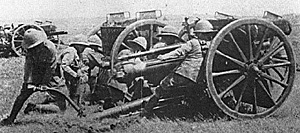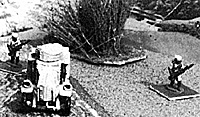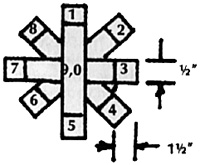 World War One, as the name implies, was a global struggle. But unlike World War Two most people fail to think of the First War beyond the charnel house that was the Western Front. This article, and those to follow will concentrate on the more off-beat areas of the war; areas seldom explored for their wargaming potential.
World War One, as the name implies, was a global struggle. But unlike World War Two most people fail to think of the First War beyond the charnel house that was the Western Front. This article, and those to follow will concentrate on the more off-beat areas of the war; areas seldom explored for their wargaming potential.
At right, British Royal Horse Artillery on the Mesopotamian Front in 1917.
Undoubtedly one of the famous people from the Great War was T.E. Lawrence. Perhaps because of the re-release of the motion picture "Lawrence of Arabia" or perhaps because of the unusual nature of the man and his war, Lawrence provides fertile ground for gamers.
Lawrence conducted a highly successful guerrilla war against the Turks, especially in conjunction with Allenby's campaign in Palestine. Lawrence tried studiously to avoid general battles with the Turks unless it was unavoidable or if his fighting blood was up. He was very sensitive to the effect that combat losses could have on his command. As he said, "being irregulars... an individual casualty is like a pebble dropped in water: each may make only a brief hole, but rings of sorrow widen out from them. We could not afford casualties." That philosophy, coupled with the strategic position of the Turkish Army, strung out as they were along a single line of communications, the railways, helped Lawrence decide to launch hit and run raids for which he may be best known.
Lawrence raided the Turkish rail link by planting explosives and blowing up trains. There were many variations on a theme. Of one such raid Lawrence wrote:
-
"The best stunt was the hold up of a train. It had two locomotives and we gutted one with an electric mine. This rather jumbled up the trucks, which were full of Turks shooting at us. We had a Lewis (a LMG), and flung bullets through the sides. So they hopped out and took cover behind the embankment and shot at us between the wheels at 50 yds. Then we tried a Stokes gun (a mortar), and two beautiful shots dropped right in the middle of them. They couldn't stand that (12 died on the spot) and blotted away to the East across a 100 yd belt of open sand into some scrub. Unfortunately for them the Lewis covered the open stretch. The whole job took ten minutes and they lost 70 killed, 30 wounded, 80 prisoners and about 25 got away."
Regular Arab Force
Operating along with the irregular Arabs was a regular Arab force, the Arab Northern Army. Although this force fluctuated in strength it consisted at one point of a brigade of infantry, a battalion of mule mounted infantry, a battalion of the Camel Corps and eight guns. In addition the British added three Rolls Royce armored cars, two Talbot cars mounting 10# guns, a company of the Egyptian Camel Corp and four aircraft. The French kicked in a detachment with two mountain guns, four machine guns and ten automatic rifles. The irregulars joined and left the army in an unpredictable way.
Gamers will find gaming this part of the First World War to be a delightful combination of the "romance" of colonial battles with the additional twist of armored cars, trains and planes. Most colonial rules can be adapted without much fuss for use in any WWI colonial era battle. Additionally, some of the currently available WWI rules, like OVER THERE,* are very useful since they already take into consideration the technological mindset of WWI.
*[OVER THERE rules are available from Rivertown Hobbies, P.O. Box 54184, Cincinnati, OH 45244.]
Figures
Figures for gaming the Lawrence era are becoming more and more numerous. In 15mm, equipment can be purchased in the form of Minifigs and Iron Brigade tanks, armored cars and trucks. Planes and trains are widely available in 1/72nd scale (I have been blowing up Revell's Orient Express for months now). Figures can be purchased from Minifigs colonial packages. Turks can be made up from late Egyptians by filing off just a few pieces of equipment.
The British in pith helmet from the colonial sets or WWI British in cloth hat will all be usable. In 25mm the equipment problem can best be solved by going to train and hobby stores and looking for metal model cars in scale, like the Cars from Days Gone By line. Falcon Miniatures makes a dandy little 25mm Rolls-Royce armored car which I highly recommend. Lindbergh Line classic aircraft makes an SE 5A aircraft which fits in well with the troop scale. Obviously any company that makes 25mm colonials can be an excellent source of figures; however the good folks at Frontier Miniatures make a line of figures expressly for the period. Most of the figures have a variety of head choices for a great deal of variety.
 At right, Armored car patrol in East Africa, 1916, using 25mm Falcon armored car and Frontier Kings African Rifles.
At right, Armored car patrol in East Africa, 1916, using 25mm Falcon armored car and Frontier Kings African Rifles.
Sources of Information
Those of you that are seeking additional information on this period of history may wish to consult the following sources for information:
Nicolle, David, Lawrence and the Arab Revolts, Osprey Men at Arms #208, 1989. This little booklet is much more than just the Arabs and Lawrence. The author touches on the Sanussi rebellion, the French problems with the Tauregs during the war and other such events. The photos and plates are first rate.
Hart, Liddell, Colonel Lawrence: The Man Behind the Legend, Dodd Meade and Co., 1934. This book can be found at many second hand book stores and is a good little book to purchase. Hart explores the military Lawrence and describes many battles in enough detail to create good gaming scenarios.
The Marshall Cavendish Illustrated Encyclopedia of World WarI is another excellent multi-volume source. If your local library does not have it you might suggest they purchase it.
What follows is an attempt to adapt The Sword and the Flame* for WWI era combat. The adaptation presented here should serve as more of a jumping off point than as a destination. You may find ideas here that work or it may trigger even better ideas on your part.
*[The Sword and The Flame and Rule Supplements are available from Greenfield Hobbies, 2350 Burdette, Ferndale, MI 48220]
TROOP QUALITY
Before the game begins each player will roll a pair of D10 to determine the morale and training level of each unit in his force. Refer to the troop quality chart.
AMMUNITON SUPPLY
Unless playing in a campaign, ammunition supply will be limited as in the supplementary rules of TSATF.
ORGANIZATION
1. Each Turkish, regular Arab Army and European platoon will be 20 figures strong. One Turkish figure and up to two of the Arab and European figures may be bombardiers (armed with hand grenades). One other infantry figure of an infantry platoon may be armed with an automatic weapon.
2. Each Turkish, Regular Arab and European mounted unit wil consist of 12 mounted or 9 dismounted figures. Indian cavalry and Turkish cavalry may be lance armed.
3. Irregular Arab mounted units will be composed of 12 figures when mounted and 9 when dismounted. All irregular Arab units are considered to be rifle armed. One such unit may be considered to be Lawrence's bodyguard if Lawrence is on the field. Up to 1/2 of Lawrence's bodyguard may be armed with automatic weapons.
4. Irregular Arab infantry will be 20 figures strong and are rifle armed.
5. Artillery and machine gun units are considered to have a crew of four. The machine gun will NOT roll for jamming.
6. Stokes mortars are available in any 1917-18 scenario. The Stokes has a crew of three as well as a minimum and a maximum range.
7. For every squadron of British or Indian cavalry there maybe a machine gun troop. Such a troop would be of 12 figues when mounted and of two machine guns with crews and one officer casting when dismounted.
MOVEMENT
(See Movement Chart)
The method of movement is the same as in TSATF except for aircraft, autos and trains. Scouting is as in TSATF with two exceptions.
1. Arabs should be able to outscout the Turks by twice the distance normally allowed for scouting.
2. Aircraft may uncover any hidden unit under the groundspace covered by the wingspan of the aircraft along its flightpath. Aircraft cannot detect units in buildings.
FIRING
(See the Firing Chart)
The method of firing is conducted in the same manner as TSATF. Players will notice that the ranges for several weapons have been increased to account for improved WWI technology.
In addition to the normal rules of firing, the following are in effect:
Stokes Mortar: This has a minimum range of 10" and a maximum range of 36". When rolling a Stokes on short range (10-18"), a die roll of 6 indicates a miss. On long range (18.1-36"), a roll of 5,6 indicates a miss. If the target is not missed -- roll for effect on the appropriate chart. Each gunner counts as three figures firing. Any Class IV target becomes a Class III target. Any Class III target becomes a Class II target.
Grenades: They have a 9" range and may only be thrown by the bombardier. A roll of 6 indicates that the grenade has missed. If the grenade did not miss count the grenadier as three figures firing and add that number to the rifle fire.
Automatic Weapons: All platoon automatic weapons count as three figures firing.
Key Figures: It takes a key figure hit to knock out a bombardier, automatic weapon gunner, Stokes gunner, artilleryman or scout unless they are the only figures remaining. EXAMPLE: A Turkish infantry unit with 12 men left fires at a target 9" away with ten rifles, one bombardier, and one automatic weapon. This would give the Turks the firepower of 16 men (10 rifles, + 3 for the grenade, + 3 for the automatic weapon).
Artillery: Range is unlimited. However, when firing at targets over five feet away use the bombing spider (see aircraft rules below) and follow the same procedure to see if a target has been hit. If the target has been hit use the long range artillery table as normal.
MELEE
Melee is conducted as in TSATF. See the attached melee chart.
AIRCRAFT
1. At the beginning of every turn, unless otherwise designated in the scenario, there is a 15% or less chance of an aircraft appearing for either side in the game.
2. Aircraft will use a card like other units. Aircraft will roll six dice for movement. There is no terrain penalty for aircraft. Aircraft must travel in a straight line. To turn an aircraft 90 degrees or less the player must discard one of the six dice. A plane may turn as many times as it has dice to do so.
3. Aircraft may make three bombing runs and three strafing runs; but only one run per turn. The bombing runs must come first.
A. On a bombing run the player may drop up to two bombs (for a total of six). When making a bombing run the player places a bombing spider on the target (see below for spider dimensions). The player then rolls a D 10. The number generated indicates where the bomb will fall. A roll of a 9 or 0 indicates a direct hit on the target. A roll of 1-8 will only result in a hit if the colored portion of that numbered spider leg is over a target. ANY figure caught in the bombing spider is diced for. Each bomb counts as 8 figures firing. ANY POOR QUALITY TROOPS AND IRREGULAR ARABS MUST TAKE AN IMMEDIATE MORALE CHECK IF HIT.
B. Strafing runs are diced for as long range machine gun fire. The plane counts as six figures when firing. A roll of six jams the guns for the remainder of the game.
4. Aircraft may move and fire before the firing phase by deducting one die from movement.
5. Aircraft may be shot at by small arms fire and machine guns. All aircraft are Class II targets. Only key figure and leader hits score. A key figure hit reduces the available dice for movement by one. Any time the aircraft dice total 6 pips or less the plane must immediately exit the playing area. Any ace wounds the pilot and the aircraft must leave the playing area immediately. If the ace of hearts is played the pilot is killed and the plane crashes immediately just off the playing area.
6. If two opposing aircraft would appear on the table at the same time they are considered to be dogfighting in another area and neither enter the playing area. Any opposing plane on the table when an opposing aircraft is successfully diced for will be required to leave the table that turn without bombing or strafing.
Six dice are rolled for aircraft movement. The aircraft will stall out if the air speed (dice pips rolled) is 6 or less & must leave the playing field. Therefore there is always a chance that an aircraft could stall out (6 dice each with one pip = 6 or stall out speed). EACH aircraft hit removes a die. So there is an increasing chance that the aircraft will stall out and crash. Obviously when there is one die left it would be impossible for the aircraft not to stall out and must permanently leave the table.
TRAINS
Six dice are rolled for the engine, the number of pips generated equals the current speed of the train. (We do not find this apparent inconsistency of speed with that of aircraft to be a problem. It can be accounted for by minor undulatons in the grade, engine age and maintenance.) Every hit on the train takes away one die. Obviously when all dice are removed the train is stopped.
ARMORED CARS
Armored cars use five dice for movement on roads and three dice for cross country movement. Armored cars will roll for mechanical break down before movement when traveling cross country. A roll of 6 will cause a breakdown. The next turn and every turn thereafter until repaired, the player may attempt to fix the car on a roll of 1 or 2.
Armored cars will be able to move and fire during the movement phase by subtracting one movement die. All armored cars fire as machine guns with a crew of four. They are considered a Class IV target.
THE BOMBING SPIDER

The bombing spider is made up of four pieces of cardboard or mounting board, each measuring 12 inches long and 1/2 inch wide. The last 1 1/2 inch of each arm of the spider is marked off in red or some other distinguishing color. Each 6 inch arm of the spider is then numbered 1-8. The center, where the four arms cross, is numbered 9, 0.
Back to Table of Contents -- Courier Vol. IX No. 4
Back to Courier List of Issues
Back to Master Magazine List
© Copyright 1990 by The Courier Publishing Company.
This article appears in MagWeb (Magazine Web) on the Internet World Wide Web.
Other military history articles and gaming articles are available at http://www.magweb.com